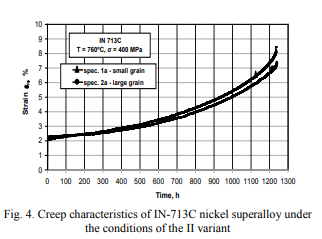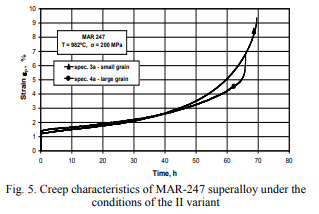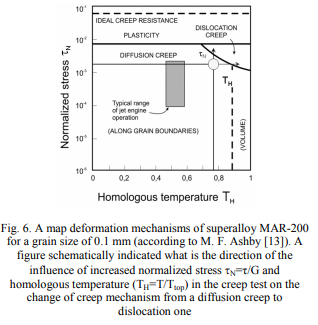Analysis of the map of deformation mechanisms indicates that plastic deformation in the process of superalloy creep may occur as a result of diffusion or dislocation creep depending on the test conditions (temperature and stress). In the conditions of diffusion creep according to a model of R. L. Coble and Nabarro-Herring steady creep rate significantly depends on the grain size and is described with the relations (1) and (2), respectively [12-14]:
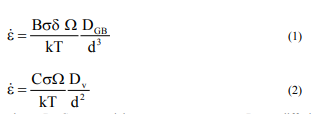
where: B, C – material constants, σ – stress, Dgz – diffusion coefficient across the grain boundaries, b – the Burgers vector, k – Boltzmann constant, T – absolute temperature, d – grain diameter., Ω – atomic volume, d – effective thickness, Dv – Lattice diffusion coefficient While in case of case of dislocation creep mechanism it is described by the relation (3) and is not dependent on the grain size:

where: A, n – material constants τ – shear stress, Def-diffusion coefficient, G – shear modulus b – the Burgers vector, k – Boltzmann constant, T – absolute temperature, d – grain diameter.
It should be noted at the same time, that under conditions of creep tests deformation of the material as a result of dislocation creep, volume diffusion (Nabarro-Hering model) and across the grain boundaries (Coble′model) may take place simultaneously with different intensity. The contribution of each of these processes in the deformation depends on the temperature, stress, grain size and the structure of their boundaries [12-13].
3. The results of investigations and discussion of results
Images of selected cast structures studied under the conditions of variant II of the creep tests are presented in Table. 3. Preparations for microscopic observation were pickled in the Marble's reagent. Table 4 and 5 list selected morphological parameters of macro-and microstructures of the test samples. Basic parameters of the macrostructure were evaluated using MetIlo program. The tests were performed on cross-sections of samples (d0 = 6mm) after the creep test.
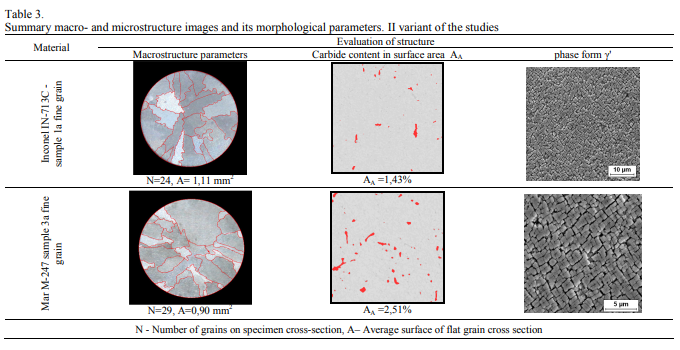
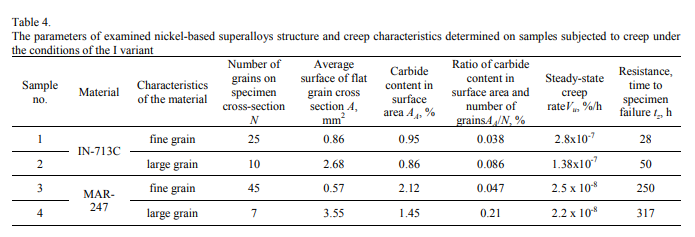

Metallographic studies indicate that the effect of only volume modification was the formation of coarse-grained structure in superalloys, and simultaneous volume and surface modification resulted in the formation of fine-grained structure (Table 4 and 5). Studies on precipitations of carbide phases, significant from the point of view of strengthening the tested alloys and sustainability in creep conditions showed their greater surface AA in superalloy MAR-247 (Table 4 and 5). Primary carbides, mainly in the form of "Chinese characters" occurred in the area of grain boundaries [2].
Tab. 4 and Table 5 summarizes macrostructure stereological parameters of examined superalloys in relation to the creep characteristics such as sample rupture time tz, steady creep speed Vu.These values are important in defining the factors that determine the stability of materials under high-temperature creep.
Figure 2 and 3 shows characteristics of creep of superalloys IN713C and MAR-247 developed on the basis of creep tests carried out in accordance with variant I of the study.
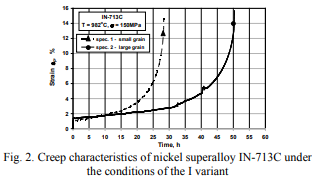
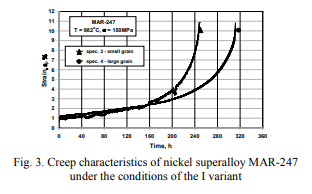
In case of superalloy IN-713C stability will substantially depend on the size of the macrograin and reaches the value t = 50 hours for a sample with a coarse-grained structure and 28 hours for the sample with the comminuted grain as a result of the volume and surface modification (Table 4). Similarly, in a high-temperature creep of alloy MAR-247 the size of the macrograin fundamentally influences samples rapture time. Stability of the samples with a coarse-grained structure was over 20% greater than the comminuted grain samples.
As is clear from the data presented in Table 4 stability of the materials tested was furthermore strongly dependent on the the area of AA carbides disclosed in their microstructure. This effect is well illustrated by new parameter AA/N,(surface area of carbides referred to the number of grains in the sample table, Table 6). Regardless of the tested superalloy with an increase in this parameter stability in the creep test tzwas higher, and the steady creep speed Vu, reached lower values (Table4).
The results of research and analysis indicate that diffusion creep across grain boundaries determined the steady creep speed Vu, and stability of superalloys in completed tests (Table 4). We can assume that in the given circumstances of the I test variant (t=980° C, σ=150MPa) stability (time to sample rupture) under diffusion creep determined the slip across the grain boundaries. It conditioned the processes of formation and growth of cracks. In this case the decisive factor for the stability of the superalloy was the ratio of the surface area of the carbides to the amount grains on the cross-section of the sample (AA/N). Higher value of this expression corresponds to greater stability of the material in a creep test.
The analysis of the test results obtained with the parameters corresponding to variant II of creep tests (Fig. 4, 5, Tab. 5) indicates that, by increasing the axial stress σ.(which results in the increase of normalized stress τ/G) no influence of the macrograin size on the creed stability was observed both in case of superalloy IN-173C and MAR-247 (Fig. 4 and 5). Differences in creep durability were only few hours. This shows that under these creep test conditions the material deformation process takes place mainly under dislocation mechanism, rather than, as previously observed (Fig. 2, 3) under Nabarro-Herring matrix diffusion mechanism (volume) and across the grain boundary by Coble (this resulted in the increase in the stability of the material with a coarse-grained structure). Described influence of creep test parameters on change of materials deformation (distortion) mechanisms due to the increase of the axial stress σ is well explained by figure 6.
